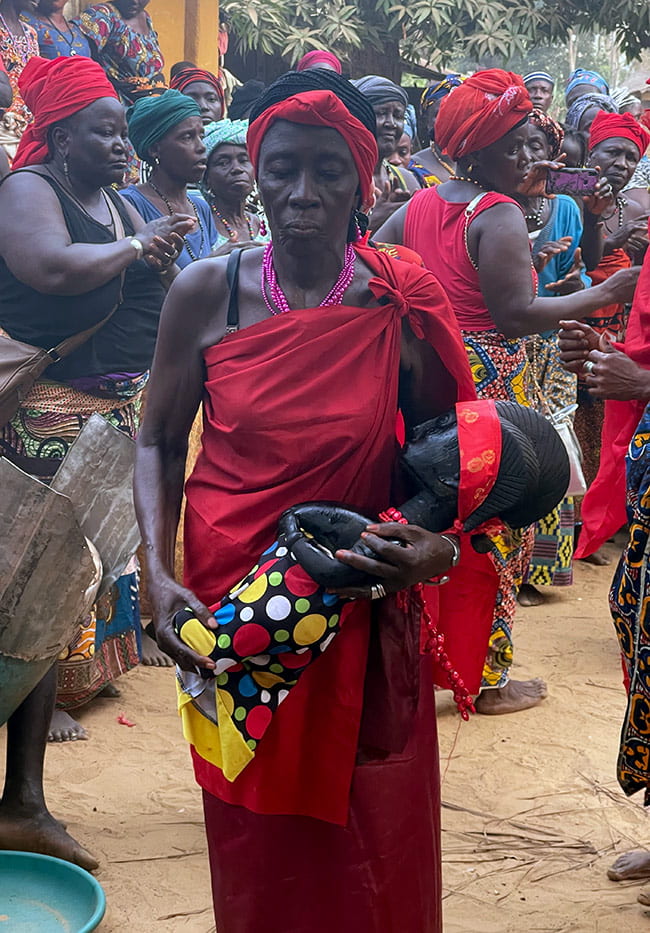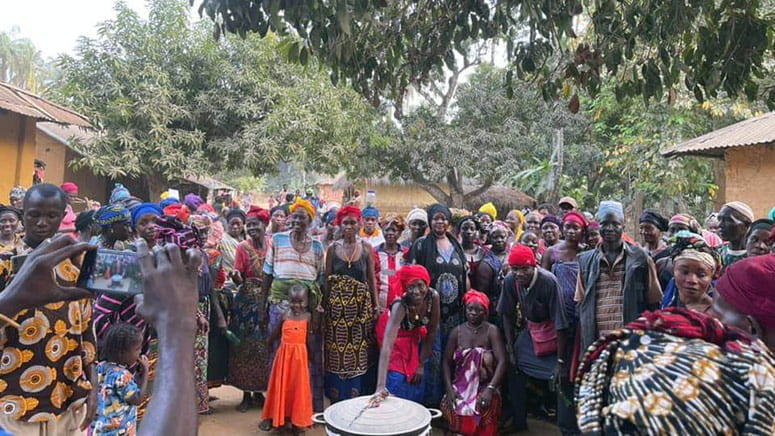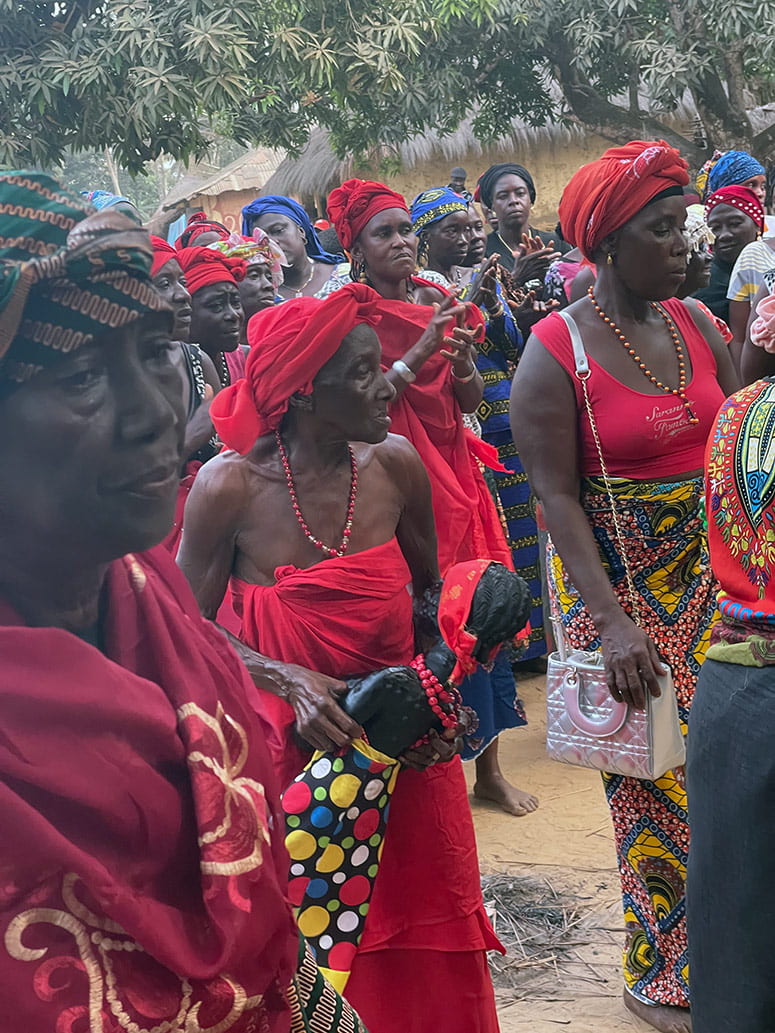
Featured
An Earth-centered Indigenous Spiritual Revival in Guinea
Preserving Nalu culture, language, and herbal knowledge.
N’gnondö ceremony in the remote village of Koukouba in Guinea. Bintou Camara
By Bintou Camara
For centuries, Indigenous cultural and pagan traditions have coexisted with the dominant religious forms of expression that served to perpetuate colonialism, especially in Africa and Latin America. These traditions have been passed down through oral tradition from elders to their children for many generations.
In recent years, Guinea has witnessed an unprecedented groundswell of the animistic religion native to Guinea’s Nalu tribe. This is one of many revivalist Indigenous movements that are part of a long tradition of resistance and rebellion against the dominant and generally oppressive power structure driven by the economic exploitation of one sector of society over another, based on ethnicity and/or language.
I am an activist for climate justice, and revivalist Nalu spirituality is the primary source of my strength and inspiration. A descendant of the Nalu, I am learning the Nalu language and am a practitioner of Nalu spirituality. The Nalu community is another foundational pillar of my spiritual and moral strength. I am convinced that essential elements of the Nalu religious tradition speak directly to the grave challenges we face today.
Humanity now faces massive chaos and misery, if not extinction, at the hands of climate change. Spiritual revival among Indigenous peoples helps point the way to creating societies based on human dignity and autonomy principles. Developing a greater appreciation for the ancient wisdom of these traditions is helping to break the chains of the destructive forces that are ruining our planetary home and robbing our children and grandchildren of their possible futures.
As an African woman who is currently studying religion in the United States, I am always seeking to express my feelings for my people, the Nalu. In the US context, I often find myself using the example of the ghost dancers, a nineteenth-century spiritual revival movement among Native American Indigenous peoples.
As with the ghost dancers, Indigenous-based religion in Africa defines itself over and against the dominant mainstream forms of religion and traditional religious organizations. It serves to fill in a religious void felt by Indigenous peoples whose cultural identities have been suppressed over the course of centuries by an oppressive and exploitative mainstream or privileged economic class. While ghost dancing did result in increased repression and exploitation of Indigenous peoples, the importance of this spiritual movement for the moral and spiritual grounding and uplifting of the people should not be underestimated; it undoubtedly contributed to their survival and well-being.
The extent to which human beings feel motivated to treasure and protect the earth is impacted by various attitudes, perceptions, practices, and beliefs concerning our relationship with nature. There is great religious and spiritual diversity in Africa, with many competing belief systems, replete with unique ceremonies, rituals, and symbols. It is important to note that not all African activists are environmentalists, and not all African spiritual movements are concerned with the environment.

The N’gnondö ritual is an annual ceremony celebrated by the secret society of women healers in homage to the deceased bearers of the tradition. The ceremony consists of cooking a huge meal for mostly women, playing traditional instruments, singing spiritual songs, and praying for the preservation of the tradition and the protection of the last bearers’ souls. Bintou Camara
Still, unique voices in African spirituality are emerging as part of a growing chorus of voices demanding climate justice. Those voices are empowered and driven by an Indigenous religious revival in Africa calling for a return to more Earth-friendly public policies to help Africans survive the coming chaos resulting from climate change. This is especially important since Africa is projected to be one of the areas hardest hit by increasingly frequent extreme weather events. The dire environmental crises faced by Africa and the world require a holistic approach to healing nature, with an emphasis on our responsibility (both individual and collective) to respect and honor our harmony with our natural environment.
The priestess from the sacred forest of Koukouba Village is dedicated to plant medicine and is consulted for her healing expertise. Forests throughout the African continent supply herbal remedies as well as food. The relationship of the Nalu with their geographic location is definitive, defining them and providing orientation for their lives and religious rituals. The Nalu religion also stresses the critical importance of natural occurrences, recognizing the supremacy of nature and the way that it indeed often determines the fate of humanity. The relationship with nature is always deeply spiritual and woven into every aspect of life in Nalu religion, culture, and society.
The interdependence between humans and nature is central to the religious ideology of most African communities. Human beings, as well as other species, are seen as linked to nature in a symbiotic relationship. Emphasis is placed on collective responsibility to ensure that resources are not vanishing. This emphasis on environmental conservation is seen as a collective responsibility emerging from the Indigenous and accumulative knowledge of millions of people. These values of humility and respect for nature are embedded in African communities. They lead us to want to protect our natural environment and are the source of our resilience.
Wangari Maathai, founder of Africa’s Green Belt Movement, outlined the values that are most important in African worldviews, including love for the environment and respect for the earth’s resources. The better the person, the more they love, respect, and care for nature. It is thought that when these values are ignored, they are replaced by vices such as selfishness, corruption, greed, and exploitation and might even lead to loss of life. Our experiences and observations teach us that the physical destruction of nature also leads to the destruction of humanity. If our environment is severely wounded, with the air, water, and soil contaminated by heavy metal and plastic residues, we eventually die.
Environmental conservation is seen as a spiritual and social responsibility in Nalu and other Indigenous African worldviews. It is also understood that anyone who goes against those values will face punishment from or in the spiritual world. Various Indigenous African worldviews see rain frequency and soil fertility as dependent upon the well-being of wildlife populations, and humans are dependent on their local wildlife, as was the case in North America with the buffalo. Thus, the annihilation of sacred sites, the indiscriminate killing of sacred animals, or cutting down sacred trees in the forest results in spiritual disapproval. Punishment is thought to take the form of drought and deadly disease. Humanity and the spiritual world are supposed to revere nature and love her, care for her as one would one’s mother.
Many African women who work in the fields and forests feel the same way as the women described by Indigenous activist Briceida Iglesias:
For us, the plants, the trees have life, they have a spirit, that’s why we have to respect it, take care of it and protect it. The women in my community have planted trees, bananas, cassava. We are dressing Mother Earth.—Briceida Iglesias, the Mesoamerican Alliance of Peoples and Forests, Panama1
“Dressing Mother Earth” is a perfect example of the familial intimacy expressed by Indigenous people, including the Nalu, when they talk about the natural world. Traditional Nalu practices shape and maintain an ecological balance, guiding our peoples in the sustainable use of plants and animals, all of which serve to protect our natural environment and the other species with which we respectfully cohabitate.
Before Guinea’s occupation by Europeans in the nineteenth century, Nalu was the spirituality and language of the Nalu tribe, which was the largest tribe in the area. The Nalu were the original inhabitants of the region of Kanfarandé, a sub-prefecture of Boké. After the fall of the Nalu Empire, led by King Dinah Salifou Camara, this cultural heritage was decimated.
In addition to the enslavement of the population, the mining industry was the principal reason why the Europeans came and mainly why they stayed. The colonizers quickly developed and eventually turned Guinea into the lead bauxite producer for the first world, since it has the world’s largest bauxite reserves; bauxite is the principal ore used to make aluminum. While large international corporations continue to strip the land of natural resources, the bulk of the exploitation is close to our ancestral home, Boké, where there are six endangered Indigenous tribes and the Nalu people. We were stripped of our land because it was strip-mined. They gave it back to us this way.

During the ceremony, leaders are dressed in red attire representing the healers. They bring the Deity “N’demba” out to fulfill their prayer. Only the high priestesses are able to hold the “N’demba” or “Nimba,” the deity of fertility and protection worshipped by both the Baga and Nalu tribes of Guinea. Bintou Camara
Indigenous peoples around the world tell similar stories. Capitalist economic development led by the West and driven by Eurocentric worldviews has been the primary motor of global environmental degradation.2 Here are three more of the many voices recorded in the New York Times article “The Guardians of the Future” that describe the extraction of natural resources leading to the decimation of the environment and the destruction of Indigenous communities:
The oil that comes out of the Amazon, the gold—these natural resources feed development models, but we are left with garbage, oil pollution and mercury in the rivers.—Gregorio Mirabal, Coordination of Indigenous Organizations of the Amazon Basin, Venezuela
My community and territory has already been destroyed by palm oil plantations. There is only a very small forest left. The loss of the territory, the forest, the traditions, the cultural rituals—these things are what makes us who we are. When we lost that, we lost everything.—Mina Susana Setra, the Indigenous Peoples Alliance of the Archipelago, Indonesia
My grandparents were forcibly evicted to make way for the construction of a hydroelectric plant. As a result, our relationship with our sacred sites changed, as did our way of highlighting our identity through our language. It’s an example of how a development can destroy the very life of Indigenous peoples.—Sara Omi Casama, the Mesoamerican Alliance of Peoples and Forests, Panama3
As these accounts demonstrate, the natural resources upon which Indigenous peoples depend are inextricably linked to their identities, cultures, and livelihoods. Even relatively small changes in temperature or rainfall can make their lands more susceptible to rising sea levels, droughts, and forest fires.
Meanwhile, as the climate crisis escalates, activists fighting to protect what remains of the world’s forests are at risk of being persecuted by their governments, and some are even at the risk of death for their environmental activism.4 For decades, Indigenous activists have sounded the alarm, and hundreds of land defenders have been murdered, with their warnings ignored.5
Indigenous land defenders throughout the world emphasize that they must be seen as key leaders and partners in global environmental efforts. Aissatou Oumarou of the Network of Indigenous and Local Populations for the Sustainable Management of Forest Ecosystems in Central Africa puts it this way:
We are part of the solution. We have our local knowledge, and we have ancestral knowledge. Give us a chance to bring our knowledge to the table.
Monica Ndoen of the Indigenous Peoples Alliance of the Archipelago, Indonesia, stresses that “Indigenous youths are the future leaders and policymakers” and says “keep[ing] the knowledge . . . and language alive, . . . I think that’s really the face or the picture of what hope is.”6
I dream of rehabilitating the stripped land of Tchikondè village in Kanfarandé, where my grandparents lay, turning the devastated land into an ecovillage beginning several meters below the original level of the ground. I hope to implement Indigenous educational systems to support and preserve the spirituality, culture, and language of the Nalu tribe. To create our ecovillage, it was crucial for neighboring villages to approve the project. Therefore, the village of Dobali proposed that I partake in a ceremony with their healer, asking permission from the village spirit to implement the project.

The N’gnondö ceremony took place in Koukouba, one of the last authentic Nalu villages in the subprefecture of Kanfarandé-Boké. Bintou Camara
To ensure the spirits support my project, I successfully participated in a two-day initiation ceremony, called Assimô, involving several spiritual baths and sacrificing a red goat and offering a red rooster’s blood to the river. This benediction preceded presentation to the spirits at the altar before the village. The ceremony gathers women from the Nalu and Manduri tribes, dressed in traditional initiation attire, to perform a ritual dance. The great spirit of the Nalu tribe, Banda, is represented throughout the ceremony. Embodying the deity of protection and guidance, one newly initiated young male is chosen to personify the spirit by performing a ritual dance.
The ceremony was successful, and with the spirit’s blessing, the project began with the establishment of a primary school immersed in the Nalu language and an empowerment center to train women in natural herbalism. The Nalu people recognize the spiritual energy connected to their land and resources, with importance placed upon the many herbalist healers Nalu spirituality is known for. I intend to continue to empower our women to preserve the Indigenous educational systems while producing natural healing oil, herbs, and food to support their socioeconomic and cultural growth.
Working to save and protect our planet Earth led me to dive into my roots and spiritual heritage in search of practical wisdom that can contribute to the struggle to save our environment. In our Nalu spiritual revival, I find values and practices that point toward a way of living that can be our salvation. I am incredibly proud of how our religion is an Earth-based spirituality. Our traditional practice of systemic resource utilization has already enabled large areas of our land to regenerate, due to our promotion of sociocultural unity in the community.
Reviving the physical and spiritual sides of our native beliefs, we will create sustainable environmental health and preserve our natural resources. This is our way of being loyal to our purpose, our creator, our children, and their children. I see this purpose clearly when I gaze in the faces of my twin boys, only a few days old as I write this. Learning and working together in community, we will cherish and rebuild our culture and environment so our children may live.
Notes:
- “The Guardians of the Future,” photographs by Camila Falquez, text by Isvett Verde, New York Times, October 1, 2022.
- China is now competing with the West as a polluter, yet it has resisted making environmental commitments under the United Nations framework.
- From “The Guardians of the Future.”
- Oscar Lopez, “Mexico Named Deadliest Country for Environmental Activists,” New York Times, September 29, 2022.
- A September 2022 report by the international NGO Global Witness found that more than 1,700 land defenders were killed by hitmen, crime groups, and governments in the previous decade, and Global Witness stated that these figures were likely to be an underestimate; Global Witness, Decade of Defiance: Ten Years of Reporting Land and Environmental Activism Worldwide, September 2022.
- Oumarou and Ndoen quotes also from “The Guardians of the Future.”
Bintou Camara is a specialist in sustainability and African Indigenous knowledge systems. She recently founded a center for local and Indigenous knowledge systems in Guinea, through which she conducts ethnographic research on the revival of Nalu cultural heritage. She holds a master of science in negotiation and conflict resolution from Columbia University. She was accepted into the MTS program at Harvard Divinity School and will begin her studies in August 2023.
Please follow our Commentary Guidelines when engaging in discussion on this site.


Beautiful! So glad you are doing this for the next generations to come. I have been studying the Eastern ancient philosophies for 10+ years and I am 100 % certain that this information is exactly the same just put into a different “outfit”. Would love to hear how your studies are going in the future.